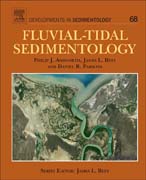
Fluvial-Tidal Sedimentology provides information on the 'Tidal-Fluvial Transition', the transition zone between river and tidal environments, and includes contributions that address some of the most fundamental research questions, including how the morphology of the tidal-fluvial transition zone evolves over short (days) and long (decadal) time periods and for different tidal and fluvial regimes, the structure of the river flow as it varies in its magnitude over tidal currents and how this changes at the mixing interface between fresh and saline water and at the turbidity maximum, the role of suspended sediment in controlling bathymetric change and bar growth and the role of fine-grained sediment (muds and flocs), whether it is possible to differentiate between 'fluvial' and 'tidally' influenced bedforms as preserved in bars and within the adjacent floodplain and what are the diagnostic sedimentary facies of tidal-fluvial deposits and how are these different from 'pure' fluvial and tidal deposits, amongst other topics. The book presents the latest research on the processes and deposits of the tidal-fluvial transition, documenting recent major field programs that have quantified the flow, sediment transport, and bed morphology in tidal-fluvial zones. It uses description of contemporary environments and ancient outcrop analogues to characterize the facies change through the tidal-fluvial transition. Presents the latest outcomes from recent, large, integrated field programs in estuaries around the worldGives detailed field descriptions (outcrop, borehole, core, contemporary sediments) of tidal-fluvial depositsAccesses new models and validation datasets for estuarine processes and depositsPresents descriptions of contemporary environments and ancient outcrop analogues to characterize the facies change through the tidal-fluvial transition INDICE: Context Tidally-influenced fluvial sediments: their setting and sedimentological importance Deciphering the relative importance of fluvial and tidal processes in the fluvial-marine transition Streamwise variation of stratigraphic architecture within the fluvial-marine transition Modern Turbidity maxima in tidal rivers: phenomenology, theory and modeling The broader implications of sedimentologic- and associated-trends across the tidal-fluvial transition of the Fraser River, Canada Sedimentary styles and evolution of the fluvial-tidal transition over the mid-Holocene to Present: Lower Columbia River Investigation of the three-dimensional flow field within estuarine tidal flow reversals. The ichnology of fluvial tidal settings as viewed from modern and fossil perspectives Sedimentology of a tidal bar within the fluvial-marine transition; River Severn Estuary, UK Ancient Paleo-Orinoco tidal-fluvial distributary channels from tide-dominated delta lobes and estuaries Point bar deposits of the Tremp Fm Red Garumnian facies: sedimentological, petrological and paleontological evidences of tidal influence (Pyrenees, Spain) A reappraisal of large heterolithic channel fills in the Upper Permian Rangal Coal Measures of the Bowen Basin, Queensland, Australia: the case for tidal influence Do common tidal indicators really measure the importance of tidal processes in ancient deltas? Evidences of an Early to Early-Middle Eocene tidal incursion in southern Amazonia (Madre de Dios Basin, Peru) Neslen Formation (Campanian) tidal-fluvial channels and their point bars, Floy Basin, Book Cliffs, Utah The importance of geologic reservoir characterization in the successful application of CO2 enhanced oil recovery and storage programs: fluvio-tidal deposits, USA Incised architectures in tidally-influenced seaway settings; a rock record study informed by modern analogs Resources Characterising alluvial architecture of the McMurray Formation, Alberta, Canada: challenges for bitumen recovery Reservoir models in the fluvial tidal transition Sedimentological criteria for distinguishing stacked dune-trough muds from muds in IHS-insights from McMurray Fm and modern analogues Tidally-influenced fluvial, estuarine and bay-fill successions, northeast Alberta: Geological controls on resource development Fluvial to tidal transition zone facies of the McMurray Formation as exposed along the Christina River (Alberta, Canada)
- ISBN: 978-0-444-63529-7
- Editorial: Elsevier
- Encuadernacion: Cartoné
- Páginas: 525
- Fecha Publicación: 01/11/2015
- Nº Volúmenes: 1
- Idioma: Inglés
